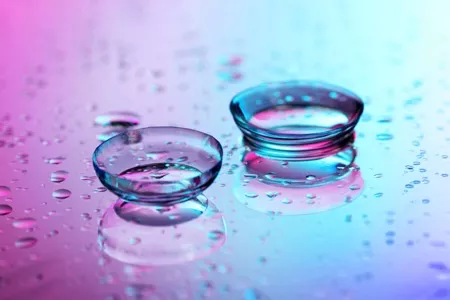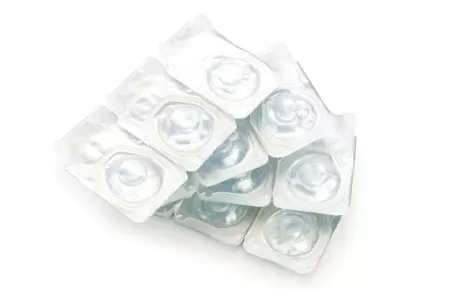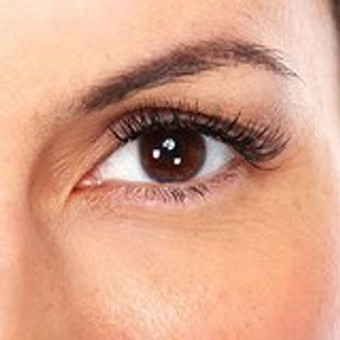Contact lenses are a vision correction device alternative to glasses. Contacts are available in various materials, forms, colors, and wearing schedules. Millions of people around the world wear contact lenses for vision correction or aesthetic purposes.
This article examines the types of contact lenses available and their specific use for improving your vision
What Are Contact Lenses?
Contact lenses are thin curved lenses placed directly on the eyes to correct vision problems, protect an injured eye, or in some cases for cosmetic purposes. Contact lenses have been around for several decades, though in recent years they have become increasingly popular.
Contact lenses are medical devices, therefore the Food and Drug Administration (FDA) regulates their sale and use, this includes cosmetic contact lenses. Improper use of contacts can cause eye health complications or vision loss.
What Kind of Contacts Should I Get?
The type of contact lens you should get depends on your specific needs and lifestyle. For example, if you have astigmatism, then toric contact lenses are most suitable for you.
If you operate on a busy schedule and do not want the hassle of cleaning your contacts lenses every day, then daily disposables will be most suitable for you.
| Contact Lens Type | Ideal For | Shop Now |
|---|---|---|
| Toric | Astigmatism | Shop Now |
| Daily | Those with busy schedules | Shop Now |
For those who desire comfort above all else, you may benefit most from conventional soft contact lenses. The best way to determine what type of contacts is best for you is to speak with an eye care professional about your individual prescription requirements and lifestyle preferences.
Contact Lens Material: What Are They Made Of?
The first contact lenses were made from hard, glass materials. Luckily, today contact lenses are made from soft plastic polymers.
Soft contacts are made from hydrogel and silicone hydrogel polymers, while hard contacts are made from polymethyl methacrylate (PMMA) and are generally referred to as rigid gas permeable (RGP) lenses.
Hydrogel
Hydrogel is one of the most common contact lens materials. It is used in the manufacturing of soft contact lenses and it is a thin, gel-like, water-containing polymer.
Hydrogel is easy to use and rests on the eye comfortably. It is an excellent contact lens for dry and sensitive eyes due to its biocompatibility.
Silicone Hydrogel
Silicone hydrogel combines hydrogel with silicone to allow more oxygen to enter the cornea, making this material suited for long-term use. However, these materials tend to accumulate proteins and debris from tears.
Polymethyl Methacrylate (PMMA)
PMMA or Plexiglas is a stiff plastic used to manufacture a hard contact lens. It is biocompatible, provides clear vision, and can be molded to fit the eye.
However, PMMA does not allow as much oxygen to the eye compared to other materials, putting users at risk of ‘overwearing syndrome. Thus, manufacturers are designing rigid gas-permeable lenses to allow for breathability.
Soft Contact Lenses
Traditional soft contact lenses are made from soft plastics like hydrogel and silicone, allowing the eyes to receive more oxygen.
These lenses are comfortable, easy to use, and correct several vision disorders; including myopia, hyperopia, astigmatism, blurred vision, and presbyopia. Some soft contacts come as daily disposables, while others can be worn for several days before disposal.
Silicone Hydrogel Contact Lenses
Silicone hydrogel contact lenses combine hydrogel and silicone to provide oxygen permeability up to five times of standard hydrogel lenses, making these contact lenses an ideal choice for people with stronger prescriptions or those who may suffer from dry eyes.
These contacts are easier to handle and can be worn for long periods of time, though they may carry a higher risk of collecting protein deposits.
Gas Permeable Contact Lenses

Gas-Permeable (GP) or Rigid Gas Permeable (RGP) contact lenses are made from durable materials that allow oxygen to enter the eyes.
These lenses are crafted using silicone-containing materials and are smaller in diameter than soft contact lenses by covering less of the cornea. RGP lenses are quite rigid, so there is less risk of tearing or ripping. These lenses are easy to maintain and do not require frequent replacement.
Gas-permeable contact lenses maintain their shape on the eye and provide sharper vision. However, it takes time for the corneas to adapt to them, therefore they have a higher possibility of dislocating during physical activity due to their small size.
Hybrid Contact Lenses
Hybrid contact lenses attempt to provide the comfort of soft contacts and sharp vision that GP lenses have. Hybrid contact lenses have a rigid gas-permeable center and a skirt made from soft lens material. Hybrid lenses are ideal for individuals with strong astigmatism or those who use soft lenses but desire clearer vision.
Learning to insert, remove, and care for hybrid lenses takes some time, so they may not be ideal for everyone. Fitting hybrid lenses often takes more time than other lenses and is often a more costly choice.
PMMA Lens
PMMA lenses are made from polymethyl acrylate (Plexiglas), a lightweight, shatter-proof glass alternative.
PMMA is transparent, inert, and biocompatible with the eye. This lens is malleable so it allows for it to be shaped to correct refractive errors. However, PPMA is not widely used for contact lens manufacturing as users find it difficult to adjust to its rigidity.
These lenses are not gas permeable, which can obstruct oxygen flow into the eye. Manufacturers design PPMA contacts to be as small as possible to reduce the surface they cover. PMMA lenses are also designed to be shaped in a way that creates a space between the lens and cornea surface, making it possible for tears to get under the lens and supply the eyes with oxygen. However, this space also makes it possible for lenses to fall out.
Conventional Vs. Disposable Contacts
If you are new to wearing contacts, you may be wondering whether to choose regular or disposable contacts. Your preference for conventional vs. disposable lenses depends most on your lifestyle and what you desire most in a contact lens.
Traditional contact lenses have been around for a while and are very popular among their users. Although they require more proper cleaning and handling than traditional glasses do, disposable contacts are designed to be worn and replaced with a fresh pair daily.
Disposable Contact Lenses
Disposable contact lenses are popular for their ease of use. Users will replace these contacts after use with a fresh pair each day, week, or month depending on their wear schedule. Disposable contacts may result in more waste generation from their frequent replacement than conventional lenses and may be more expensive in the long term.
Weekly, Biweekly, and Monthly Contact Lenses
Weekly contact lenses are designed to be used and thrown away after one-week maximum. They are more durable than daily disposable contacts, and some are approved for overnight wear (though it is best to refrain from sleeping in contacts). Weekly contact lenses are ideal for people who desire the convenience of a fresh pair of contact lenses but prefer not to replace their lenses daily.
Biweekly contacts are designed for continuous use for up to two weeks. Weekly and biweekly contact lenses must be cleaned and stored at the end of each day.
Monthly contact lenses can be used for up to 30 days before being replaced with a new pair. You must always properly clean and store your contact lenses each day to prevent the buildup of eye deposits. Additionally, they are more environmentally friendly than other types of lenses and often more affordable.
| Contact Lens Type | Features | Shop Now |
|---|---|---|
| Weekly/Biweekly |
|
Shop Now |
| Monthly |
|
Shop Now |
Daily Contact Lenses
Daily contact lenses must always be removed each night before sleep. Since there is no need to clean or store them, users can wear and replace these contacts with a fresh pair each day, as they are not approved for extended use. These lenses are great for people who do not want to handle lens cleaning and storage.
| Daily Contact Lens | Top Features | Shop Now |
|---|---|---|
| DAILIES AquaComfort Plus 90 Pack |
|
Shop Now |
| 1-Day Acuvue Moist 90 Pack |
|
Shop Now |
| Biotrue ONEday 90 Pack |
|
Shop Now |
Extended Wear Disposable Contacts

Extended-wear disposable contacts are designed to be worn continuously for up to seven days and six nights. Nonetheless, newer silicone hydrogel contacts can be worn for up to 30 days straight.
This type of contact lens is ideal for people with active or unpredictable schedules, and/or those with severe refractive errors who need to see clearly at all times. This includes those who have unpredictable schedules and require the need to sleep with contacts in; i.e., firefighters, night-shifts workers, etc.
Extended-wear contacts are made with gas-permeable materials allowing oxygen flow into the eyes and this design makes them suitable for more prolonged use. However, these lenses carry a higher risk of infection and can therefore lead to eye irritation or inflammation.
Conventional Contact Lenses
Conventional contact lenses are worn for several months up to a year. They require proper cleaning/handling regularly and disinfection. These are available as daily or extended-wear contacts.
Nevertheless, advances in disposable lens technology have resulted in a steady decline in the demand for conventional lenses. These lenses carry a high risk of infection due to deposit buildup and protein formation as a result of extended use.
Types of Contacts Based on Condition
Some contact lenses are designed to correct specific vision problems. In the section below we will explore the types of contacts based on the eye conditions they’re designed to correct.
Toric Lenses
Toric contact lenses are designed to correct astigmatism, a refractive error resulting from an irregular curvature of the cornea or lens.
The shape of the cornea in people with astigmatism means that the eyes refract light unevenly, leading to blurred and/or hazy vision resulting in the inability to see fine details. Toric contact lenses provide refractive powers on the horizontal and vertical orientations designed specifically to correct astigmatism.
| Toric Contact Lens | Top Features | Shop Now |
|---|---|---|
| Acuvue Oasys for Astigmatism 6 Pack |
|
Shop Now |
| Biofinity Toric 6 Pack |
|
Shop Now |
| 1-Day Acuvue Moist for Astigmatism 30 Pack |
|
Shop Now |
Toric lenses are designed with thin-to-thick zones, lens truncation, and ballasting to ensure the lenses stay properly fit to the eyes. Every eye with astigmatism is unique, so a doctor must fit toric contacts due to their specific orientation.
Wrongly fitted toric lenses can affect visual acuity. Toric lenses come in the form of daily contacts, extended wear, and even colored contacts.
Multifocal and Bifocal Contacts
Multifocal contacts have multiple prescriptions on a single lens, while bifocal contacts have two prescriptions. The term ‘multifocal’ describes any contact lens with more than two lens powers on one lens. Multifocal and bifocal lenses are prescribed to correct presbyopia; an age-related inability to focus on close objects. People with presbyopia struggle to read up close and often experience blurred vision
| Bifocal/Multifocal Contact Lens | Top Features | Shop Now |
|---|---|---|
| Biofinity Multifocal 6 Pack |
|
Shop Now |
| 1-Day Acuvue Moist Multifocal 90 Pack |
|
Shop Now |
| DAILIES AquaComfort Plus Multifocal 90 Pack |
|
Shop Now |
Multifocal contacts have varying powers on a single lens that allow transition between the prescriptions for reading, distance, and intermediate correction. Therefore, wearers won’t need to alternate between reading glasses or single-prescription contacts. Multifocal and bifocal contacts provide sharp, natural vision and have an easy adaptation period. Some lenses may also be used to correct myopia, hyperopia, and astigmatism.
Spherical Contact Lenses
Contact lenses are shaped differently to address specific vision errors. Spherical contact lenses are designed to replicate the shape of the eye.
They possess the same optical power throughout the lens and are used to correct myopia, hyperopia, and presbyopia. Due to their even shape, spherical contacts cannot correct astigmatism or vision errors that arise from the eye’s curvature.
Custom Contact Lenses
Some people find that no contact lens can meet their vision needs due to an irregularly shaped cornea, strong astigmatism, or general discomfort from wearing regular contacts.
Custom contact lenses are tailor-made to meet specific individual needs for clearer vision and comfort.
Scleral Lenses
Scleral lenses are specialized lenses made from gas-permeable materials and designed to treat eye-related conditions like keratoconus, dry eye, and post-surgical complications, or to help people who have trouble using contact lenses due to an altered cornea. Since they do not touch the eye, scleral lenses rest on the sclera (the white part of the eye) and are technically not contact lenses.
The space between the back of the scleral lens and the corneal surface contains sterile saline fluid that hydrates the eye, fills in corneal irregularities, and provides a perfectly rounded eye surface leading to clear vision overall.
Myopia Control Contact Lenses
Myopia control contact lenses are a new type of single-use contact lenses that slow the progression of myopia (shortsightedness) in children. Some children develop myopia and see it progress as they grow older.
Myopia is the most frequent cause of corrective visual impairment worldwide, and these specialized contact lenses correct and slow down the progression of near-sightedness in children.
Monovision Contact Lenses
Monovision contact lenses are worn on one eye to correct near vision and on the other to correct far vision. These lenses address the difficulty in changing focus between far and close objects in patients with presbyopia.
Monovision lenses work by tricking the brain into thinking that the lens is part of the eye. Due to this, monovision contact lenses have an adjustment period, as the brain needs time to get used to the new lenses. The lens for far vision is typically placed on the dominant eye.
Other Contact Lens Options
Contacts for Dry Eyes
Having dry eyes can make using contact lenses a bit inconvenient, as dry eyes can cause pain, burning, or a gritty sensation like an object in your eyes. However, there are several contact lens options for people with dry eyes.
Colored Lenses
Colored lenses allow wearers to change their eye color for cosmetic purposes or for vision correction. All contact lenses are medical devices, therefore you still need a prescription for colored contact lenses
| Contact Lens | Colors Available | Shop Now |
|---|---|---|
| Air Optix Colors 6 Pack |
|
Shop Now |
| DAILIES Colors 90 Pack |
|
Shop Now |
| 1-Day Acuvue Define 30 Pack |
|
Shop Now |
Special-effect Lenses
Special effect lenses are soft opaque contact lenses used for costume and novelty purposes. They cover the eye color and their center lies over the pupil to allow you to see clearly.
Like other contact lenses, special effects lenses are medical devices and require a prescription.
Prosthetic Lenses
Prosthetic lenses mask flaws and improve the appearance of an eye or cornea damaged or disfigured by congenital abnormalities, disease, or traumatic injury.
They provide wearers with therapeutic, psychological, and cosmetic benefits.
UV-inhibiting Lenses
UV-inhibiting lenses shield the eyes from harmful ultraviolet rays from the sun. They are coated with a transparent, photochromic chemical that reflects UV light away from the eyes.
The Importance of Contact Lens Care
Contact lenses are medical devices that require proper care and maintenance. Daily disposable contacts are generally the safest contacts as they require minimal care. However, if you use conventional contacts, you must adopt strict contact lens care practices to avoid health-related risks to the eye.
Caring for your contacts extends their lifespan and protects your eyes from harmful infections. Always ensure you follow the manufacturer’s guidelines on cleaning, wearing, removing, handling, and storing contact lenses.
Handling contact lenses requires patience, practice, and proper technique to ensure the safety and health of your eyes. Here's a step-by-step guide to help you put in and remove your contact lenses with ease.
How to Put In Contact Lenses:
- Wash Your Hands: Start by washing your hands thoroughly with soap and water. Dry them with a lint-free towel to avoid transferring any debris to the lenses.
- Prepare Your Workspace: Ensure you have a clean, well-lit area. Lay out your contact lens case, solution, and a mirror.
- Check the Lens: Remove one lens from its case and place it on the tip of your index finger. Ensure it's not inside out by checking that it forms a perfect cup shape. If the edges flare out slightly, then it's inside out and you will need to flip them.
- Hold Your Eyelids Open: With your free hand, use your middle finger to hold your upper eyelid. Use the middle or ring finger of your dominant hand (the one holding the lens) to pull down the lower eyelid.
- Insert the Lens: Look upwards and gently place the lens on the lower part of your eye. Once it's in place, release your eyelids and blink a few times to help the lens settle.
- Adjust if Necessary: If the lens feels uncomfortable or isn't centered, move your eyes to look in different directions to move it into place. You can also gently massage your closed eyelid to help position the lens.
- Repeat for the other eye: Follow the same steps for the second lens.
How to Remove Contact Lenses:
- Wash Your Hands: As with insertion, begin by washing your hands thoroughly. Dry them with a lint-free towel.
- Prepare Your Workspace: Ensure you have a clean area, your contact lens case, and your solution ready.
- Position Yourself: Stand or sit in front of a mirror. It's often easier to look directly at your reflection when removing lenses.
- Hold Your Eyelids Open: With your non-dominant hand, use your middle finger to hold your upper eyelid. Use the middle or ring finger of your dominant hand to pull down the lower eyelid.
- Pinch the Lens: Look up slightly. Using the thumb and index finger of your dominant hand, gently pinch the bottom and top edges of the lens to break the suction. Be sure you're pinching the lens and not your eye.
- Remove the Lens: Once you've pinched the lens, gently slide it down to the white part of your eye if needed, and then carefully remove it from your eye.
- Store the Lens: Place the lens in its designated case compartment and cover it with fresh contact lens solution.
- Repeat for the other eye: Follow the same steps for the second lens.
Understanding Your Contact Prescription
Your contact lens prescription holds specific information regarding the type and use of contacts you need. A contact prescription contains numbers and abbreviations that may appear foreign to a new user.
However, it is quite helpful to learn how to read your contact lens prescription before shopping for contacts, especially if you are buying online. The details of your prescription ensure that you get contacts that are comfortable and safe, providing the sharpest vision.
Are Contacts Better Than Glasses?
To this question, there are no right or wrong answers.
Whether you opt for contacts or glasses is a matter of individual needs, preference, and lifestyle. You do not even have to choose between the two, as some people alternate between using contacts and glasses depending on their current lifestyle preferences.
Contact lenses conform to the eyes and provide a more natural feel than glasses do for most people. They do not significantly alter your appearance and can be used for sports or other physical activities. However, they do require special handling and maintenance which can be tedious for many people. Generally, contacts can also cost more than glasses.
Glasses are easy to use, come in different styles, and offer some form of protective eyewear against debris, wind, and dust. However, glasses can distort vision, especially for people with strong prescriptions, as they fog up in cold weather and some may not prefer the feel of them on their face. Ultimately, the deciding factors for contacts vs. glasses can be narrowed down to individual preferences.
 Save yourself from getting into rush hours and buy your contacts online.
Save yourself from getting into rush hours and buy your contacts online.







